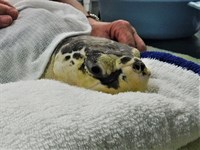
It finally seems that most of the cold weather is behind us. And almost all of the cold-stunned turtles we admitted over the winter have recovered and are anxiously awaiting a ride out to warmer waters. But as you’ve learned over the years from this column and/or your visits to our hospital rehabilitating cold-stun victims can be a long and arduous journey. Twenty-plus years of experience with hundreds of cold-stuns has taught us that serious and debilitating issues can show up months after a it looks like a patient has recovered. Thankfully our staff is always willing to do whatever it takes, no matter how long it takes to make sure that each and every turtle has the best chance make it home
Case in point is Kemp’s “Maverick” who was rescued from Hatteras Island and admitted on December 14, 2017. Maverick, along with a slew of Kemp’s we admitted from the New England Aquarium around that same time was put on a protocol of being slowly warmed, prophylactic antibiotics and topical treatments and a nutritious breakfast, and lunch and dinner if necessary. There was lots of TLC from our staff during his recovery, but after a time we noticed that some things just didn’t seem right with the way he was acting. He went from eating well on his own to being a very picky turtle who wanted to be handed every piece of food individually, and his preference could change from day to day from squid to fish to softshell crab (but no legs on the crab, please.)
Then he became a lot less active, and for a Kemp’s that’s a sure sign something is wrong. He did not want to use his front flippers and just rested at the bottom of his tank for most of the day. When Dr. Harms did the next series of radiographs on Maverick it became obvious that he had developed bone lesions; the bones near his shoulders and upper flippers were rapidly deteriorating. This is one of the major complications of cold-stunning that can take a long time to manifest, and sometimes years to resolve. Not only was Maverick in obvious pain from this condition but if we had released him earlier he would have been easy pickins’ for anything bigger and faster than a turtle that couldn’t use his front flippers.
More meds and cold laser treatments were added to Maverick’s daily routine. But his condition was barely improving. So we looked back over the years to another Kemp’s, “Dare.” Dare’s problem was not cold-stunning but a litany of bad luck injuries and maladies that in the end she could not overcome. One thing Dare did enjoy was her weekly “spa” treatment which consisted of time out of her tank with warm towels around her neck, and gentle stretches and massages on her flippers.
So we went old school and decided to try a similar treatment on Maverick, but without touching his very fragile front flippers. Now in addition to his laser treatment we apply a series of warmed moist towels to his aching body while slowly massaging his back flippers and gently stroking his carapace. You can tell by the look in his eyes and the way he relaxes into his fluffy towel that he really enjoys this attention by his “spa attendant.” Afterwards he gets to spend about fifteen minutes in the therapy pool stretching his now warmed up flippers. Although he’s far from rehabilitated the addition of spa time appears to have improved his outlook on life and his ability to paddle around the pool a little stronger and farther. Maybe there’s a lesson in that for all of us.
We’re open for tours again, and apparently just in time as nearly 400 visitors showed up on our first day, April 4. We’re on our short schedule of two days a week, Thursdays and Saturdays from 1-4 PM until June. It’s a good time to visit before the summer crowds arrive when we can get over one-thousand visitors a day. Schedule your visit now while we have a house full of rehabbed turtles and the crowds are light.
And don’t forget to contact your local state representatives to ask them to support HB169 that would make our loggerheads the official saltwater reptile of North Carolina.
By Karen Soto, communications specialist for the sea turtle hospital.



